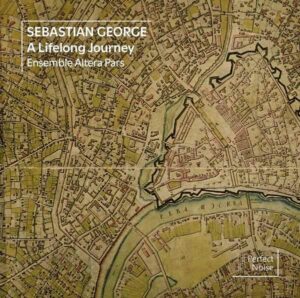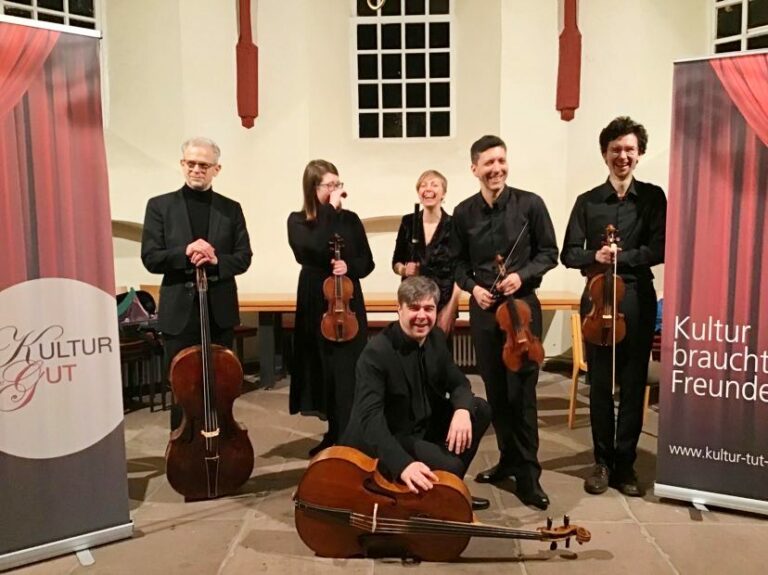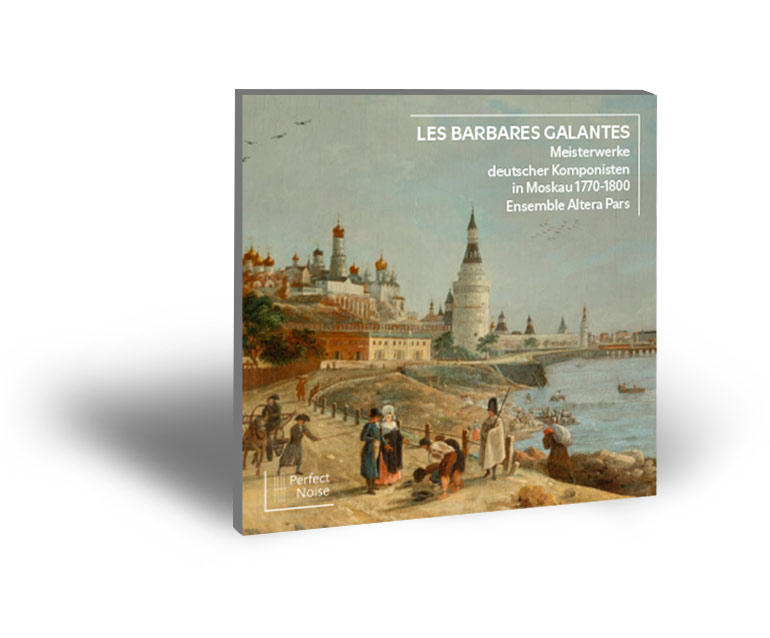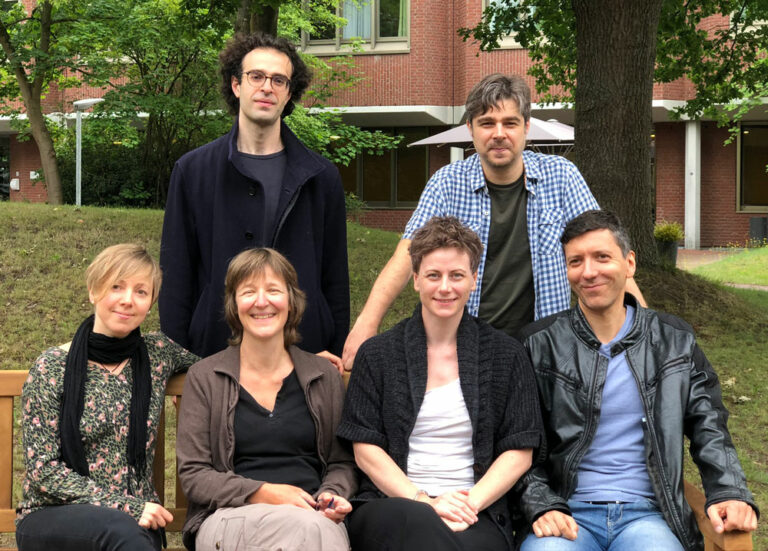
Inside
Sebastian George (ca. 1740 – 1796)
Sonata (Quartet) B-dur for fortepiano, 2 violins and violoncello, SG V:13
Quartet F-dur for two flutes, viola and cello, SG VII:1
Quartet d-moll for two violins, viola and cello, SG VI:9
Sonata D-dur for fortepiano and flute, SG V:4
Quartet B-dur for cello obligato, flute, violin and bass, SG VII:2
Quintet B-dur two flutes, two violins and cello, SG VIII:4
Impressions
A Lifelong Journey
Chamber music by Sebastian George
In the second half of the 18th century musical life in Moscow was fl ourishing.
Attracted by high wages foreign musicians undertook long and complex journeys
to Russia aiming to assimilate, perhaps even to settle there permanently.
These musical travellers found that working in a foreign country presented copious
new perspectives giving them inspiring outlets for composition.
Originally from Mainz, Sebastian George was one such kapellmeister / composer
who fi rst travelled to Moscow in about 1766. In the early 1770s, as kapellmeister
he started to form connections with Moscow University and the
courts of the Sheremetevs and Razumovskys and, on settling in Russia, soon
established himself as an entrepreneur, running a music shop in St. Petersburg
from 1776–79 that sold scores, various musical instruments and, perhaps less
predictably… wine!
Returning again to Moscow, George began a collaboration with the famous
Petrovsky Theatre, staging his only opera (in 1780) and, in 1782–83, organizing
several major vocal and instrumental concerts. George‘s family left Russia
in 1783 and although their exact route is not known, it was recorded that his
daughter stayed in Karlsruhe in 1790. Into the next decade the family returned
to Moscow where George and his musically gifted children published their own
compositions and taught keyboard to a high level.
Sadly Sebastian George’s work was completely forgotten in the 19th century
and in the fi rst chronicals of Russian music of the 18th century he was mentioned
only briefl y. George was unknown to researchers and, perhaps inevitably,
he was categorised along with the other “opportunistic foreign composer/artisans
who had come to Russia to look for work”.
This perception changed only thanks to the researcher Larisa Ivchenko who
undertook a detailed study of the catalogue of Count A. Razumovsky’s collection
(Kiev, National Library of Ukraine).
The discovery of manuscripts of George‘s orchestral and chamber works immediately
led to performances and the quality of his music instantly exceeded
all expectations. George worked in a wide range of genres; opera, cantatas, symphonies, keyboard
concertos and various chamber works – quintets, string and mixed quartets,
trios, and keyboard music with and without accompaniment.
This CD includes chamber compositions for a variety of combinations of instruments,
some of which may be quite a surprise!

Musicians
Polina Gorshkova Traverso
Dorothee Kunst Traverso
Adam Pastuszka Baroque Violin
Svetlana Ramasanova Baroque violin / Baroque viola
Evgeny Sviridov Baroque violine
Pavel Serbin Baroque violoncello
Dimitri Dichtiar Baroque violoncello
Alexander Puliaev Fortepiano

Inside
Sebastian George (ca. 1740 – 1796)
Quintett F-Dur
für zwei Flöten, zwei Violinen und Violoncello
Johann Joseph (Ivan) Kerzelli (1752 – 1820)
Trio Nr. 5 c-Moll aus „Six Trios pour Deux Violons ou Flute, Violon et Basse“
Johann Heinrich Facius (1759 – 1810)
Duetto für zwei Violoncelli Nr. 3 D-Dur aus „Trois duos pour deux violoncelles“
Johann Joseph (Ivan) Kerzelli
Trio Nr.1 a-Moll aus „Six Trios pour Deux Violons ou Flute, Violon et Basse“
Joseph Haydn (1732 – 1809)
Symphonie „Roxelane“
Anonyme Bearbeitung für zwei Flöten
Sebastian George (ca. 1740 – 1796)
Concertino G-Dur für zwei Flöten, zwei Violinen
und Violoncello
Impressions
Les Barbares Galantes
Chamber music by German composers in Russia 1770-1800
The musical culture of the 18th century produced a substantial number of excellent compositions. But history is sometimes unfair and vast amounts of music worth playing still remain undiscovered in the archives. Th is makes it immensely fascinating for us to investigate these libraries full of musical treasures.
The musical life in 18th century Russia has always been a terra incognita for European early music lovers, though music played the same pivotal role at the court of Catherine the Great as at other European courts. Most areas of life were fi lled with music, from court opera to private theatres, from concerts in the empress’ chambers to chamber assemblies in the houses of aristocrats and the bourgeois upper class. Unfortunately, we know very little about the life of 18th century musicians. Due to the 19th century’s lukewarm attitude towards the Age of Enlightenment, fi res, revolutions and archives in disarray a signifi cant number of scores is poorly preserved or even lost. In the case of the music composed in Moscow between 1770 and 1790, the question was raised as to whether it had ever existed. Th anks to meticulous research, some of this music was rediscovered.
18th century Moscow had several dozen private orchestras and theatres where key positions were held by foreign musicians. Competition among orchestras for the best kapellmeisters, soloists and the latest compositions was intense.
A number of remarkable musicians and composers were invited to Moscow. Th ey were held in high esteem in Russia but were totally forgotten aft er their demise. In Soviet times, their art used to be called “craft smanship”, which was unfair as we can see today.

Musicians
Polina Gorshkova Traverso
Instrument: Rudolph Tutz, Innsbruck 2013 (Heinrich Grenser, Dresden ca. 18. Jhd.)
Dorothee Kunst Traverso
Instrument: Martin Wenner, Singen 2018 (Heinrich Grenser, Dresden ca. 18. Jhd.)
Martyna Pastuszka Baroqueviolin
Instrument: Valentino Siani, Florenz 1638
Adam Pastuszka Baroqueviolin
Instrument from Roger Hargrave, 2016 (Guarneri del Gesu)
Pavel Serbin Baroquecello
Instrument: Anonymus, Amsterdam School, ca. 1770
Davit Melkonyan Baroquecello
Instrument: Albert Caressa, 1905, Paris
